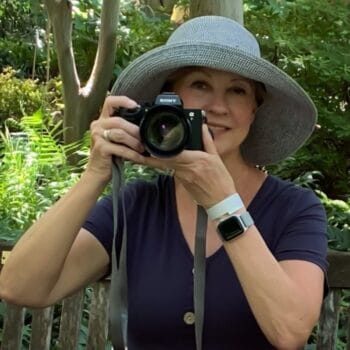Sherri Steele

Once a great communicator and listener, Jim began to lose his voice. Through my photography, I found that I could not only give him a voice, but also allow others to see that this man can still participate in life. He is still capable of doing things, living his life and experiencing joy.
August 21, 2020
I was taking a photo of Jim when he fell over a fence. I tried to take him somewhere safe, with a walking path and a chain-link fence, but he still managed to fall over the fence, into the gardens, squashing the plants beneath him. At least it made for a very funny photo.
When individuals are diagnosed with Alzheimer’s, they often lose their sense of purpose in life. Jim could no longer finish tasks because the executive functioning in his brain was being affected. But he could still take photographs — and good ones, too! He had always wanted to start photography, so I dusted off his camera and bought myself a new one and we started shooting in our garden or at the zoo. Picking up this hobby together allowed him to find a sense of purpose and pride in his photos. This was to be expected.
What I did not expect was the profound effect photography would have on my life. Since my background was in software development, I delved deeper into the software side of photography — downloading editing programs and enhancing my photos to make them look better. I discovered that I was creating my own “vision” of those I loved. I could look at my husband, my father, and even my grandchildren, and see the life behind their eyes that other people seemed to be missing.
Oftentimes, people assume that individuals with dementia-related conditions have nothing going on inside their minds. Of course, I know that Jim has a beautiful, intelligent mind, but his condition has made him more quiet. Once a great communicator and listener, Jim began to lose his voice. Through my photography, I found that I could not only give him a voice, but also allow others to see that this man can still participate in life. He is still capable of doing things, living his life and experiencing joy.
This was something that I also needed to remind of myself at times. When a person we care for is diagnosed with Alzheimer’s, it becomes easy to negate his voice, and to assume that he probably won’t remember, that he’s probably confused and probably won’t understand what I say. I truly enjoy taking photos of those I love — especially the elderly — because I find that their eyes, their wrinkles and their facial expressions really do tell a story. Photography has allowed me to reconceptualize how we communicate with each other.
Not only did photography allow me to notice the details in Jim’s behaviours and facial expressions, but it also helped me to appreciate the minutiae of my own life. I have always been a planner at heart, intuitively seeing the “big picture” or the whole garden. Through photography, I could walk through my garden and notice the spider’s web in the corner or the water droplet on a flower. I no longer worried about what would happen tomorrow, or a month or year from now. I stopped looking at the big picture, and found that I could look through the viewfinder, one inch at a time, and find joy.